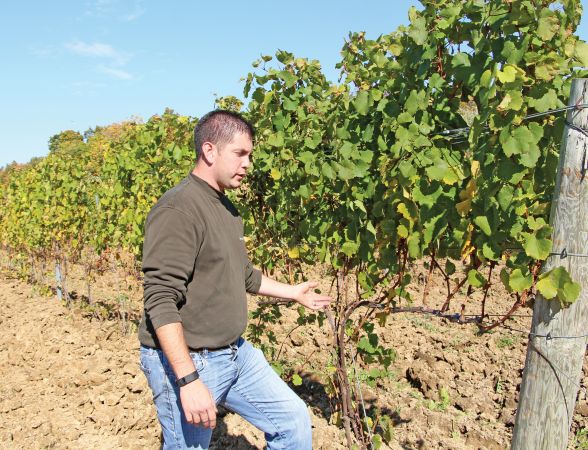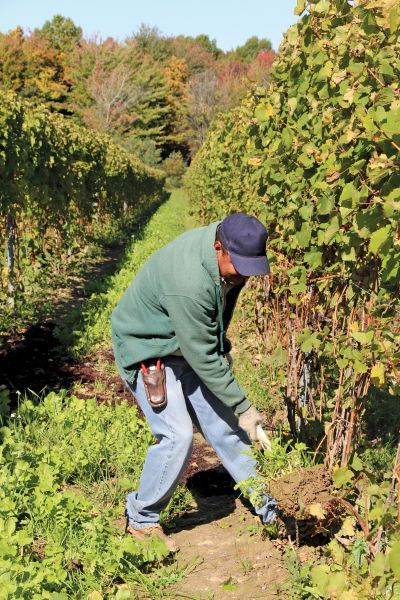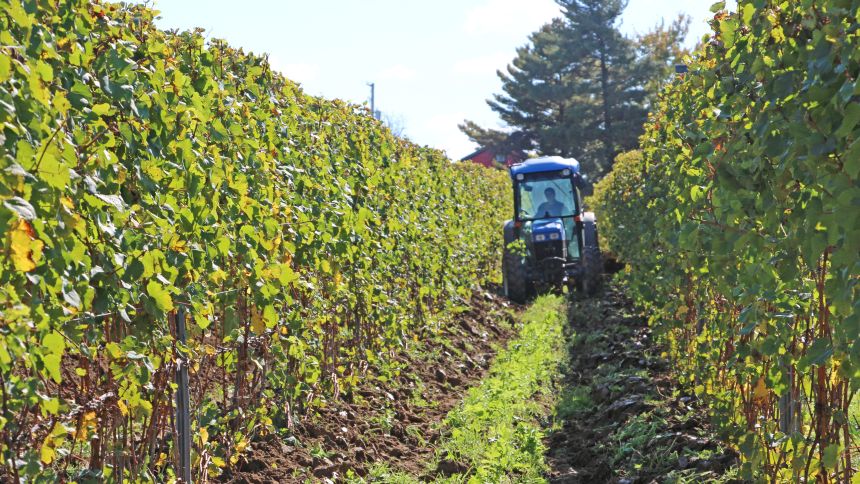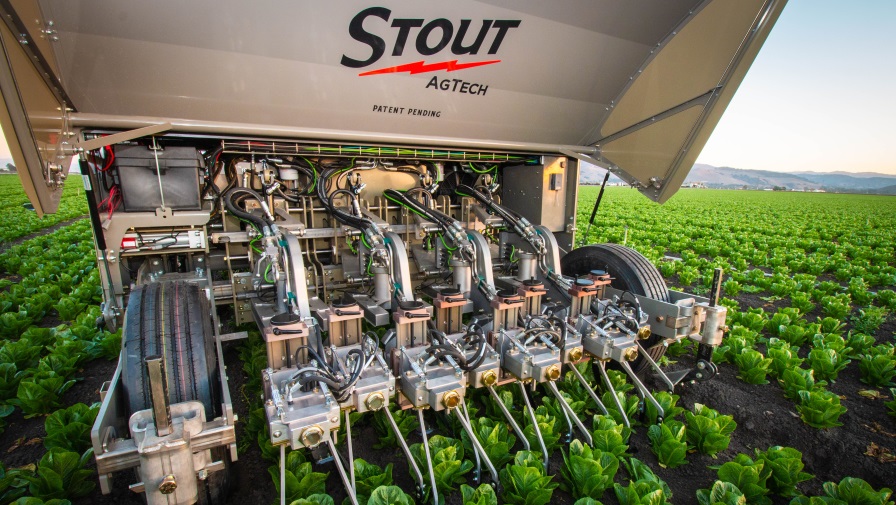Bending Down Vines Helps Young Growth Survive Sub-Zero Temperatures

A vineyard worker first cuts the young canes out of the trellising. (Photo credit: Christina Herrick)
It’s mid-October and Matt Meineke’s vineyard workers are snipping away at new growth. Instead of focusing on other tasks in Meineke’s vineyard, the three of them are cutting young canes out of trellising and bending them down to protect them in the winter.
Admittedly, Meineke’s workers said they thought he was crazy the first time he suggested it. But can you blame Meineke, owner, winemaker, and vineyard manager of M Cellars in Geneva, OH? In the past two years grape growers along the Great Lakes have felt the pinch and burn of sub-zero temperatures.

Matt Meineke of M Cellars says burying vines has paid dividends in the past two years. (Photo credit: Christina Herrick)
For Meineke it was the winter of 2014, when he needed to buy $50,000 in fruit in order to produce his wines, which made him look at other options to help sustain his vines.
With warmer winters, grape growers throughout the Great Lakes region had been lulled into complacency, thinking the types of cold snaps experienced the past two winters were unlikely to happen. But, as Mother Nature proves constantly, there are no certainties.
“For some reason we stopped laying down canes about 15 years ago, likely since we had milder winter temps and felt we didn’t need this degree of protection,” says Greg Johns, retired station manager of the Ohio State University Ashtabula Agricultural Research Station in Kingsville, OH, and now owner of Elrick’s Vineyard in Madison, OH. “We did continue to mound soil to cover the graft union of tender varieties. Our researchers had used the cane burying practice even before I was hired in 1985.”
It’s a long process for everyone in the vineyard at M Cellars, and the team of workers cover about three-quarters of an acre a day. But, as Johns says the hard work pays off when winter comes biting.
“It allows an ‘almost guarantee’ of getting a crop even if damaging winter temperatures are experienced,” he says. “It also allows a grower to select varieties that are very adapted to our growing season but not necessarily our cold winters. The goal is to protect the tender varieties (canes and fruitful buds) from damaging cold by using the insulating properties of a soil covering.”

Then, the vines are bent down and covered with soil to hold them in place before being hilled over with more soil. (Photo credit: Christina Herrick)
The Process
Meineke’s process includes cutting the growth from that year down from the first guest wire beside the row. Then, the canes are laid on the ground and covered with a bit of dirt to hold them in place. After that, a tractor with a modified vineyard disk mounds dirt over the laid-down canes.
“We choose to take at least two canes, sometimes four per vine and actually lay them down on the ground,” he says.
The process they previously used at the research station in Kingsville, OH, is a little different because Meineke doesn’t use a low-wire assist, Johns says.
“In Kingsville we would run a wire along the ground and attach it to the end posts and to an occasional line post (to hold the wire and attached canes closer to the soil line to make covering easier). Then, after leaf fall we would choose three to four canes originating from as close to the ground as possible, pull them out from the trellis wires, then tuck them under the wire to help hold them down. We would use a plastic tie to fasten the canes to the wire toward the ends of the canes (to facilitate uncovering and lifting of the canes in the spring),” he says. “Next, we would hill up soil to cover the graft union and the laid-down canes.”
In the spring, Johns says a tractor-mounted hoe would peel away the sides of the soil mound. Next, the buried wire is located and pulled up manually through the remaining soil, exposing the attached canes. The wire is often used as a catch wire during the growing season.
Growers may say burying canes in the fall and unburying canes in the spring is a lot of work and extra cost. However Johns is quick to point out growers hill up graft unions in the Great Lakes region anyway, so the buried canes will be uncovered along with the graft union.
“Whether they use the buried canes or not depends on if they need them. The common practice is to use the unburied canes, one reason being that some buried buds will die through the winter (rot perhaps) and sometimes the canes are damaged through the process and may have a higher degree of crown gall at the site of damage,” he says. “If we don’t use the buried canes we typically prune them to one to two bud spurs to encourage good candidates for next year’s lay-down.”
The idea of bending down canes may seem like an impossible and costly process for large vineyards. However, Johns says that’s not the case.
“Matt [Meineke] at M Cellars has put together a cost analysis for his operation. Growers can use this information to help them make their decision,” he says. “We have another grower in Ohio who uses a similar cane burying practice (also no tie-down wire) on more than 20 acres.”

Meinke mounds over the vines several times in order to help insulate the young growth from the impending winter. (Photo credit: Christina Herrick)
Nothing New
This is not a new concept, Johns says. In fact, burying canes is something Konstantin Frank, known for sparking the vinifera revolution in this country, developed a system for winter protection in his home country in the Ukraine before coming to the U.S.
Growers have been hilling up the graft union for a long time. It’s a must for tender varieties, says Imed Dami, Associate Professor and Extension viticulturist at the Ohio Agricultural Research and Development Center in Wooster.
“If grafted vines are not hilled up and exposed to extreme temperatures that damage all above ground, then vines would die,” he says. “Hilling up is a preventive practice used every year as insurance that you may or may not need or use.”
Growers in Michigan have used straw to insulate vines and cloth has been used in Canada. The truth is, though, that no matter how much growers protect the tender varieties from the cold, there are some components of growing this process simply can’t protect against.
“This practice does not turn a poor site into a good one! It is simply a tool a grower can use to improve the chances of harvesting a crop when growing a tender variety in a region where cold winter temperatures are experienced,” Johns says.
Dami echoes Johns’ assertion, saying it is vital for growers to understand their site.
“Know the limitations of the site and matching varieties with the site is crucial to minimize freeze damage. We now have varieties with different cold hardiness (from -5°F to -30°F or lower),” he says. “It is the job of the grower to know the frequency of minimum temp threshold of the vineyard site and plant accordingly.”
Burying canes is a ”darned if you do and darned if you don’t” process. But, Meineke estimates 70% to 80% of his vines survived the brutal winter last year. And he points out that is a risk he’s willing to take.
“It sure as heck beats 0%,” he says.










